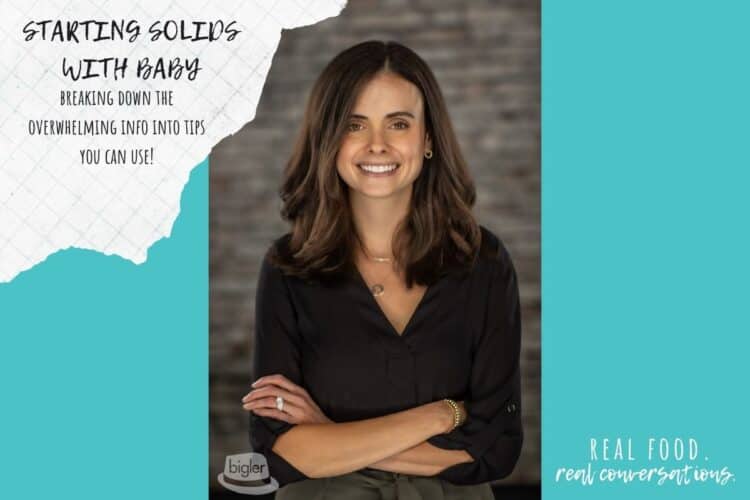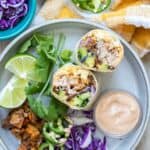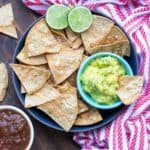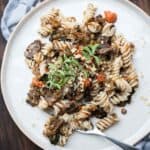Having a baby and knowing about starting solids can be scary, confusing and overwhelming. Our guest today walks us through it all!

Caitlyn Edson is a pediatric registered dietitian specializing in infants, toddlers, and young children. She is sharing all the tips to help parents feel secure and confident to start feeding their baby!
Podcast: Play in new window | Download | Embed Subscribe now! Apple Podcasts | iHeartRadio | TuneIn | Deezer | RSS | More
She has a passion for helping people feed their families confidently in a way that feels manageable. Caitlyn works with families of children starting solids (particularly baby led weaning), picky eaters, those with growth struggles, youth athletes, and more!
Grab her free starting solids guide here!
Age to Start Solids
There are certain signs of readiness when it comes to starting solids. Here are the main ones:
- Sit unassisted: not necessarily long periods of time but at least a couple seconds or in high chair being able to sit upright.
- Loss of tongue thrust reflex: when you put something into their mouth you don't want them to push it out of their mouth.
- Show interest in food: things like them watching you closely when you eat, grabbing for your food, etc.
Traditionally we used to start feeding at 4 months but current research shows these readiness skills happen closer to 6 months. But it really depends on the baby. The American Academy of Pediatrics recommends closer to 6 months.
How to Start Feeding Your Baby
There are many correct ways to start feeding your baby, you need to do what works best and feels right for you and your family. While there are things you shouldn't do, like starting too young or feed foods that are not the right consistency for their stage, overall their really isn't a wrong way to get started.
There are two main avenues with starting solids:
- Baby led weaning- the premise behind this feeding technique is infant self feeding, giving the baby real whole foods in a safe consistency. While some say you don't do purees at all with Baby Led Weaning, it isn't necessarily true. The idea is you want to get the infant to feed themselves. So you put the puree on the spoon and put it in their hand and they get it in their mouth.
- Puree feeding- starting with purees can mean making your own or buying premade foods. You can choose foods that are naturally soft like bananas, apple sauce, yogurt or you can create your own by cooking foods and blending them.
Before you start any feeding, it's a good idea to take a cpr class and learn the difference between gagging and choking because gagging is normal. You never want to stick your finger in a gagging baby's mouth because it can cause choking.
What Foods to Introduce First
Overall, you can really start with any foods you prefer. However there are a few things to avoid or think about:
- Avoid allergens if you have a family history and your pediatrician recommends it.
- Avoid honey until they are 12 months old.
- Better to avoid added salt and sugar until they are older. Not only are their bodies not able to process it well, but the flavors are too strong for them.
- Things like meat can be hard for babies to eat due to the consistency so you may want to avoid it until they are older.
We use to say to start with rice cereal but that isn't necessarily the case. You can start with anything now!
Starting with softer foods is a good first step. Things like avocado and bananas, or cooked foods like apples, zucchini, sweet potatoes and squash.
You want to cut the foods into long thin strips when first starting because they use their 4 fingers to pick up and it's easier for them.
Once they hit 9-10 months old, they develop a pincer grasp where they are able to pick up smaller pieces.
How Much to Feed Per Meal
Babies are good at instinctively knowing how much to eat, but with new eaters you should start small. It can be overwhelming to have a plate loaded with food so putting a small amount on the plate will make it easier for them.
A teaspoon or a tablespoon of a food or one piece of banana or avocado is enough to start. You can always give them more as they show interest.
Focus less on the portion and more on them and how much they show they want to eat.
How Often to Feed
When babies are first starting solids, they get the majority of their nutrition from breastmilk or formula. So they really only need one meal a day. Start with a meal that is easiest for you to sit and model eating and feed them at the same time.
Spread out solids about an hour from a bottle or breast feeding.
As they grow and have less breastmilk and formula, around 10 months, then starting with normal meals is good. As they eat more food and get more nutrition from it they will naturally take in less breastmilk or formula.
Getting in Nutrition
Overall getting a balanced meal is important. But the needs change with their age.
When you start feeding solids, make sure each plate has a source of iron, a produce and a fat. After about 2 years, make sure to include all macronutrients carbohydrates, fat and protein.
Some fats that are good for babies are avocado, full fat dairy and nut butter. Good iron sources are tofu, meats and beans. Any fruits or vegetables are great!

PS- If you liked this episode of Real Food Real Conversations, please subscribe and leave me a review!
And tag me on Instagram whenever you're listening! I reply to all my messages!














Questions or comments? Let me know below!